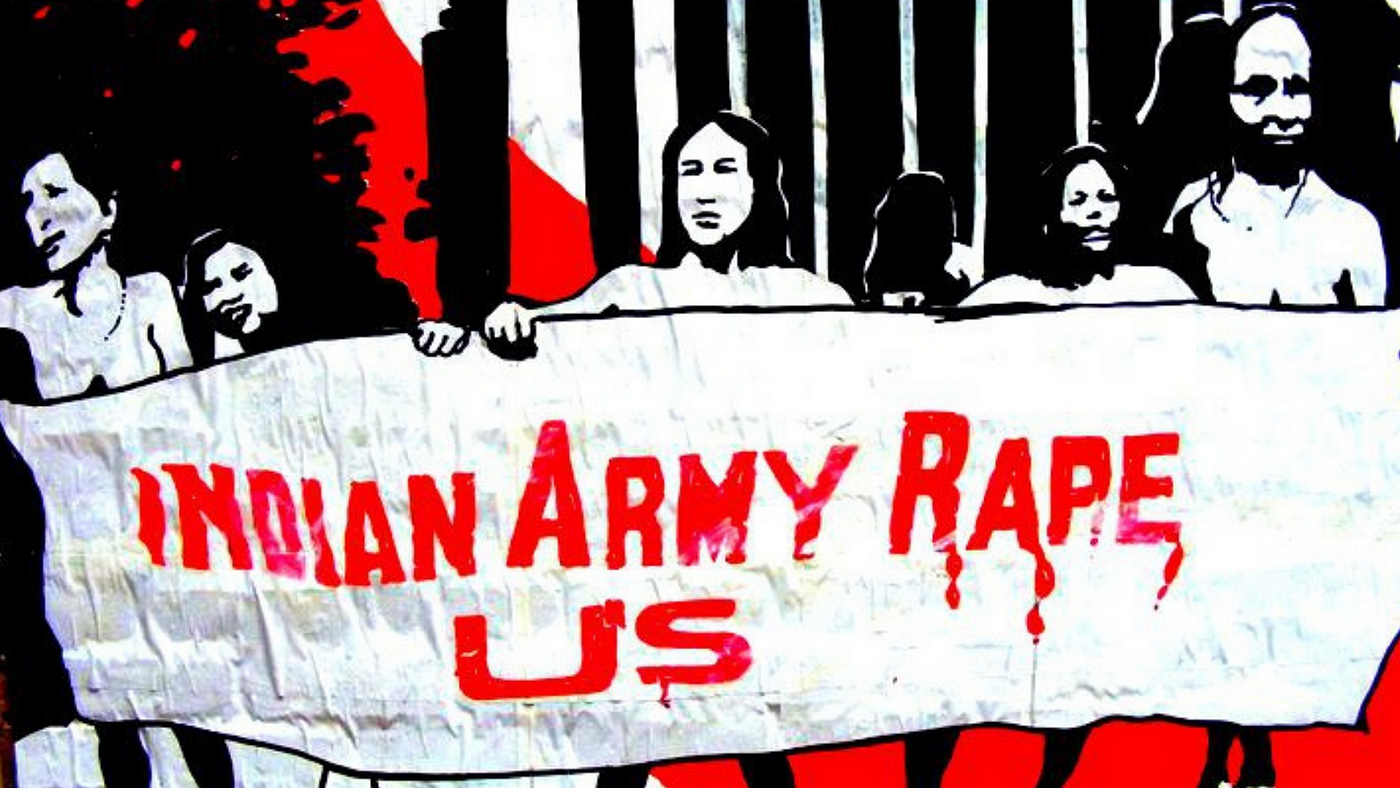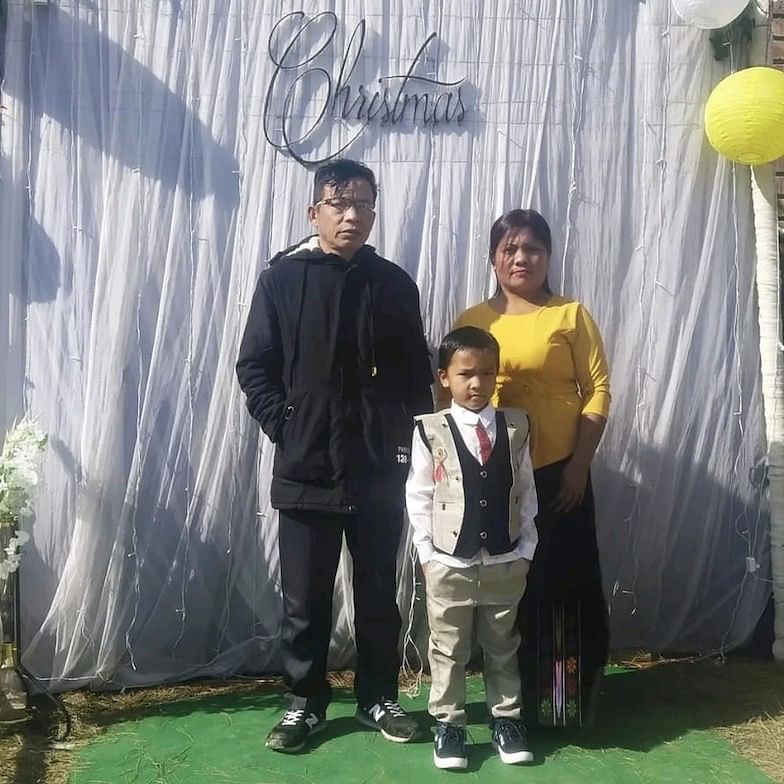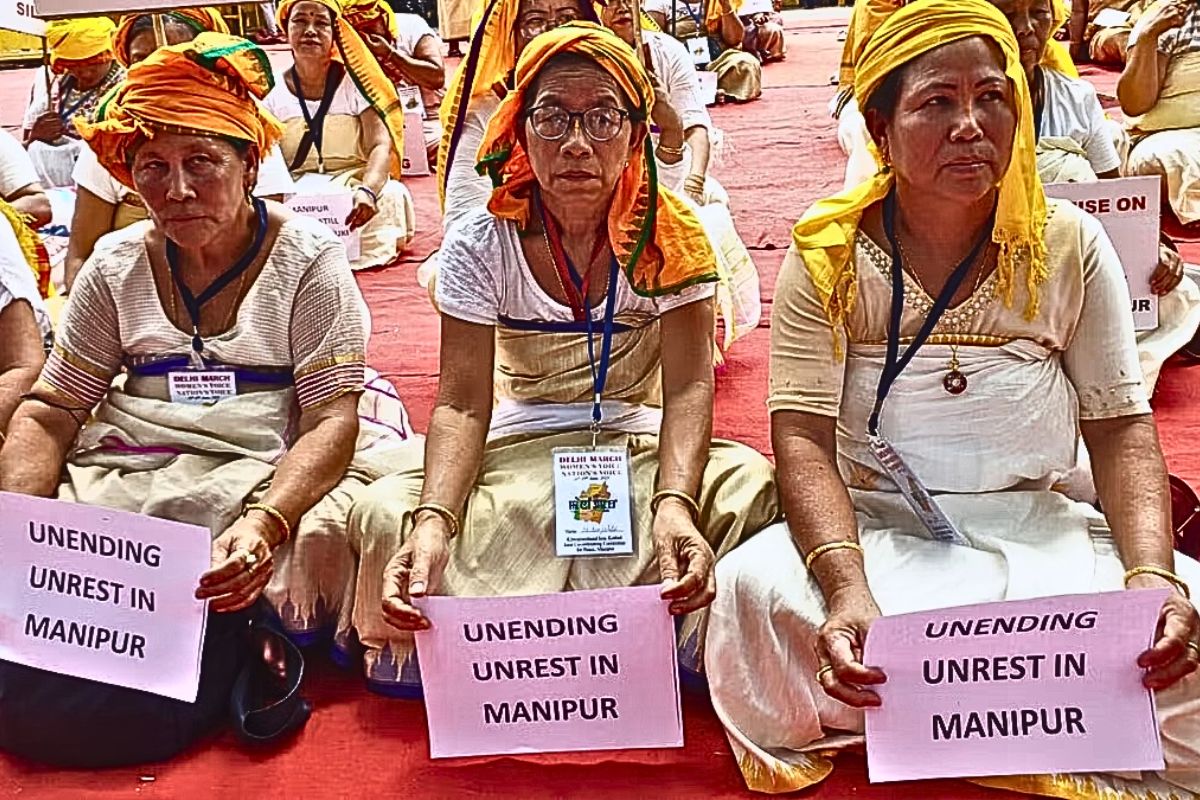Ignoring the northeastern states of India is not a new topic for the Indian government. Since the independence, whichever government is present at the centre, everyone ignored the issues of North Eastern states very rudely. But now it seems that everything is getting on nerves. As per recent data from police sources, 175 were killed, and over 1,100 were injured in four months of Manipur violence. According to IGP (Operations) I.K. Muivah, about 4,786 houses were set on fire, and 386 religious places (out of which 254 churches and 132 temples) were vandalised in Manipur. However, when the strong voices of the State, like Meira Paibi, take biased moves, it shooks the core even more!

It’s even more pathetic that not only the common public but these outbreaks of violence are such havoc that the State Governance is also failing to control them, and hence, they are looting the government arms and ammunition. It was only a week that we got the news that folks were injured in a conflict between armed individuals and security personnel. So now it is expected that the ethnic violence between two communities has crossed their boundaries, and now the public is clashing with the armed forces. Although Of the weapons that have been “lost” and looted, 1,359 firearms and 15,050 ammunition are recovered, Muivah said.
Earlier in mid of the year, an Army video from Imphal East district asserted that women protestors were “helping rioters flee,” comprising “accompanying armed rioters” in their vehicles and even using ambulances. It featured footage of women demonstrators confronting security personnel and interfering with the “movement of logistics” during the day and night. The women in the recordings are not identified, although activist women have long been present in Manipur’s civil society. Meira Paibis has been the most apparent organised face of such movements.

IGP (Administration) K. Jayanta asserted that of the 175 people who died, 9 are still unidentified. 79 of the bodies have been claimed, whereas 96 remain unclaimed. He added that in RIMS and JNIMS (hospitals in Imphal), 28 and 26 bodies have been kept, respectively, while 42 are kept at Churachandpur Hospital. The ongoing violence in Manipur has demonstrated the absolute connection of gender, class, ethnicity, and political orientations in the region’s continuance of violence.
One of the most disconcerting features of the ongoing ethnic scrabble in Northeast neighbour remains the inability of civil society voices to rise above their “ethnic” affiliations and work towards peace. This is exemplified by the acts of the Meira Paibi, an amorphous organisation of Meitei women, who have, in the past, mobilised against armed forces and police excesses, alcoholism, drug addiction and sexual violence in the State. During the conflict that has raged on since early May, however, the Meira Paibi has been working towards disrupting the operations of the Assam Rifles in their attempt to maintain peace, especially in the foothills.
These buffer zones were established to prevent further escalation of violence between arms-wielding members of the two ethnic communities, but there have been violent attacks, with the armed forces unable to respond in time due to disruptions caused, allegedly, by the Meira Paibi and others. The robbery of weapons by both the Kuki-Zo and Meitei parties and their use in the conflict has heightened the situation. However, the incapacity of the State governance and its police, and the Union government-deployed military troops, to keep the peace has also been attributed to civil society organisations encouraging people who engage in violence.
During a news conference in New Delhi on Wednesday, several Meira Paibi leaders said that the buffer zones are “unconstitutional” and do not accept them. In most cases, deploying military forces in peacekeeping is not an optimal answer. However, with the ethnicisation of law enforcement, aided by a State government that appears to have lost its legitimacy of power across ethnic divides, leading to demands for a separate administration by Kuki-Zo representatives, the presence of the armed forces and the need for buffer zones to maintain a semblance of peace in Manipur have become essential.
Are the Meira Paibi women the guardians’ of ‘Civil Society?
As the debate over the ongoing violence in Manipur goes unabated, the role of women as significant ‘civil society’ players has frequently been overlooked. Regarding women’s organisations in Manipur, the famed ‘Meira Paibi’ is the first name that springs to mind. They were founded in 1977 in the Manipur district of Kakching during intense militancy and counter-insurgency. Meira Paibis’ mobilisations have frequently been political in character, drawing inspiration from the Nupi Lan (Women’s War) of 1904 and 1939.
They shot to fame on July 15 2004, and 12 ‘imas’ (Meitei mothers) disrobed in front of the Assam Rifles headquarters in Imphal to protest the rape and killing of a Meitei woman. Women demonstrators carried banners reading “Indian Army rape us” and “Indian Army take our flesh” and successfully removed the army camp from that place. However, in the case of the current crisis, this heroic function appears to have been entirely reversed. What is surprising about the recent violence in Manipur is the testimony revealed by Zo (Kuki-Zomi-Hmar) survivors of the Meira Paibis’ direct participation in instigating the Meitei mobs.

A video emerged during the first week of the violence, showing two Kuki women wrapped by a crowd of Meitei men and women. The footage showed the women yelling at the two victims and asking their men to rape them for allegedly abusing Meitei women in the hill areas. It was eventually informed that these two females were from Khopibung hamlet in Kangpokpi district, around 2 km from Porompat in Imphal. On the eve of May 5, they were reportedly raped and killed. When their remains arrived at the Jawaharlal Nehru Institute of Medical Science(Imphal) mortuary, their parents were told of their deaths.
With the escalation of the war, witnesses who fled Imphal and were interviewed by various media outlets described how the Meira Paibis obstructed the way of tribal families fleeing for safety to adjacent army camps while aggressive crowds pursued them.
The deadly waves of revenge rapes.
When the violence erupted, allegations of rape of Meitei women by tribal groups in the hill areas circulated like wildfire. Among the assertions that have now been refuted are the following:
- On May 3, a Meitei nurse working in Churachandpur was allegedly raped by tribal gangs. Her father later stated on a news channel that she was fine and no such thing happened.
- The assertion that post-mortems disclosed the rape of 37 Meitei women early in the war. This was discredited when Shija Hospital, where the alleged post-mortem findings were obtained, said that no such exams were conducted.
- Images of a Meitei woman allegedly raped in the hill areas went viral, and Meitei demonstrators in Delhi utilised them. It was then uncovered that the woman shown in the posters was based on an old Facebook post about the domestic violence of an Arunachali woman.
Although these charges were learned wrong in a few days, the harm had been done, and many Zo women were victims of alleged “revenge rapes.” The alarming discovery of the Meira Paibis’ involvement in inciting their men to rape their State’s women and assaulting and torturing them has broken the image of their status as “guardians of civil society.”
From Guardians to Violent Perpetrators.
The conflict between two ethnic groups appears to have turned Meira Paibi into a perpetrator of violence against tribal women. Such occurrences are upsetting when they come from the acclaimed “guardians of civil society” like Meira Paibi and highlight their implicit and active involvement within the region’s existing ethnicised majoritarian political paradigm. Historically, the Meira Paibi has been relatively mute about the atrocities committed in the hill areas by valley-based rebel organisations.
One egregious example is the 2006 incident in Parbung village when Meitei militants from the United National Liberation Front (UNLF) and the Kangleipak Communist Party (KCP) raped and abused 21 Hmar women, 10 of whom were minors. The involvement of the Assam Rifles was ultimately responsible for driving the valley-based militants out of the Zo ethnic tribal territories.
On the other hand, this battle has seen Meira Paibis block an army convoy carrying four detained United National Liberation Front (UNLF) members, a valley-based banned organisation, on June 20, after they were discovered with 51mm mortars the day before.
A similar incident occurred on June 24 in Imphal East District, when over 1,200 Meira Paibis obstructed an Indian Army convoy carrying 12 Kanglei Yawol Kanba Lup (KYKL) cadres, ostensibly at the urging of the local MLA. The Indian Army was compelled to release the arrested outfit cadres by women’s crowds on both occasions.
As the violence goes unabated and demands for peace are made, it is critical to confront the intersectionality of indigenous womenfolk oppression and suffering. Civil society organisations, like the Meira Paibi, must recognise their racial and political biases in perpetuating violence against indigenous women. The high-voltage drama on July 1, when Manipur Chief Minister Biren Singh’s alleged resignation letter was ‘snatched’ and ripped by a Meitei woman, only emphasises their participation in the present political drama.
Meira Paibis’ name has been included as a participant in several FIR complaints claiming rapes and sexual assaults against Kuki tribe women. From their historic Kangla Fort demonstration for women’s rights against the Assam Rifles to this moment, where many have accused them of playing a role in sexual assaults against Kuki women, can the Meira Paibis continue to depict themselves as those standing up for Manipur’s women?
Another act of inhuman killing.
The height of killing humanity reached when an innocent childhood was brutally murdered behind the bars of ethnic violence. The news is from June 2023, when a 7-year-old kid was killed because he belongs to a Meitei mother and a Kuki father. On May 4, Tongsing Hangsing, seven, escaped with his family before a mob came to the village of Kangchup in Kangpokpi district. The family had gone to the Assam Rifles camp just outside the village the day before, anticipating violence from the Meiteis. They had been taking refuge at a water treatment facility inside the camp ever since. They reasoned that their proximity to the military troops would keep them safe from the civil conflict happening outside.

However, this was not to be. On the afternoon of June 4, a bullet splinter hit Tongsing’s head inside the Assam Rifles’ camp. The camp was caught in the crossfire since it was “in the middle” of multiple Kuki and Meitei villages.
According to an Assam Rifles officer, the child was given oxygen. However, the condition was severe. The official stated that he had two options: take the child to a hospital in Kangpokpi district’s Leimakhong town or travel to the city, Imphal, which was less than 20 km away.
It was not an easy decision. Although Leimakhong was a Kuki territory, the road to it passed via a few Meitei areas. Imphal, on the other hand, belonged to the Meitei. Many more Meitei forts would be along the route, but it was a much shorter journey. The officer chose the latter. The ambulance arrived promptly. S Ibomcha, the Imphal West police superintendent, escorted it.
It was decided that the child would be accompanied by two other people: his mother, Meena and another neighbour, Lydia Lourembam. The persons chosen were deliberate: Meena was Meitei, as was Lydia. Lydia Lourembam and her spouse, Naoton Lourembam, were among the few Meiteis in the Kuki-dominated village. Like their Kuki neighbours, they have taken refuge in the Assam Rifles camp since May 3.
The journey to Imphal starts then. The ambulance left the camp at 5 p.m. for the Regional Institute of Medical Sciences in Imphal. Along with the police cars, an Assam Rifles party escorted the ambulance. According to the official who accompanied the ambulance, they drove for around two kilometres until they reached the limit of jurisdiction.
After that, they are not allowed to venture by the Meira Paibi. Somebody spread a rumour that Kuki militants were being evacuated. After that, nothing mattered. Not that the ambulance was ferrying a critically injured child, but the two women accompanying him were Meiteis themselves. The mob attacked the police convoy and burnt down the ambulance – with Tonsing, Meena and Lidia still inside. All that could be recovered was “a couple of bones”.
)
How Does Accountability Work?
Women’s civil society organisations like Meira Paibi in Manipur have a strong voice in the State, but it is critical for the State’s “guardians of civil society” to recognise that they are not immune to sectarian and violent mobilisations. When the Assam Rifles conveyed the stranded Meiteis in Churachandpur on May 4, the Zomi womenfolk created a human chain to defend them from the onslaught of ragged mobs.

Such acts of compassion are also noted by survivors of the first violence in Imphal, who have mentioned the involvement of the Nagas and Pangals in hiding them, and particular Meiteis, who went to significant lengths to assist some of the victims in escaping. Without the intervention of these individuals, who did not lose their humanity in the face of the crowd, the number of tribal casualties would have been greater than the 70 or so who perished in the first days of violence. These murders were caused not by confrontations between warring groups, as is presently occurring in the foothills, but by mobs that slaughtered fleeing families.
Conclusion.
There is no doubt that groups like Meira Paibi have come a long way to decriminalise the wrong attributes of society, and they have been working immensely towards the development of the State. However, keeping such biases that kill humanity is not expected from this powerful organisation.
Civil society organisations like Meira Paibi may rise beyond their limited ethnic identities to advocate for justice for conflict-affected women, hence developing solidarity networks that will facilitate the process of reconciliation and peace-building. Unfortunately, it does not emerge to be the situation today. Civil society organisations, like corrupt political officials, have drummed up a fever of ethnic animosity, partly owing to repeating trauma from the atrocities. As a result, the cycle of violence has continued. History hints that only nonpartisan leadership and civic engagement between civil society and government representatives may result in a breakthrough. As things now stand, that needs a genuine alternative to the State’s existing leadership.
